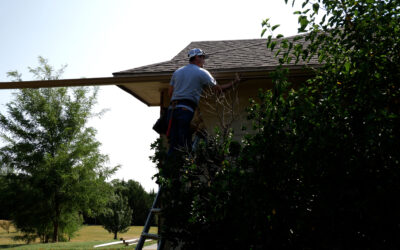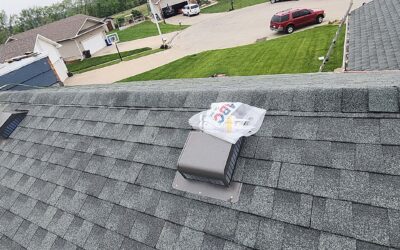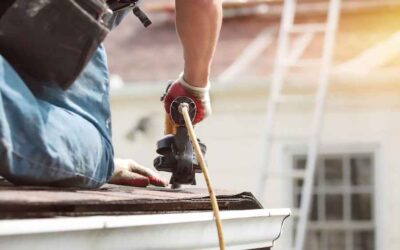Trees have a complicated relationship with buildings and the people who live or work in them. Understanding that relationship assists with landscaping planning, property inspections, and preventing damage before the next storm season.
Even if you aren’t partial to trees in your yard, your home is partial to trees for its structural members — they are beneficial when planted and maintained responsibly. Trees have many positives, but the risks need to be carefully considered before:
-
- Planting Trees
- Building a structure with existing trees nearby
- Purchasing a home or other property
- Performing a roofing or landscaping job
- Deciding on a maintenance budget
That’s why we built this resource: to help you evaluate your current trees, plan new ones, and spot potential risks before they result in costly repairs.
We’re not arborists, but we frequently deal with the effects trees can have on roofs. No part of a home or building is more vulnerable to tree-inflicted damage than roofs. Damage doesn’t always come from a falling limb or a toppled trunk. It can be slow, silent, and structural. Branches brush the same shingle for years; roots shift the soil just enough to stress the framing; moisture builds where sunlight used to reach. We’ve seen those small interactions add up. This guide is our way of helping you spot the patterns before they become problems.
Refer to the table below for a quick reference to help you determine the ideal tree distance from a building.
| Tree Type | Minimum Distance from Building | Notes |
|---|---|---|
| Small/Ornamental Trees (e.g., Serviceberry, Redbud) | 10–15 feet | Low risk, but monitor roots and branches |
| Medium Trees (e.g., Elm, Hackberry) | 20–30 feet | Ensure crown won’t overhang roof at maturity |
| Large Trees (e.g., Cottonwood, Sycamore, Walnut) | 40–60 feet | High structural & maintenance risk if closer |
How to Use This Guide
We’ve broken things down into three sections so you can find what you need quickly:
Tree Placement Risks Around Buildings
A breakdown of the most common types of risk trees present to roofs and buildings. This includes overhanging limbs, fire risk, and more. Think of it like a checklist for potential hazards.
Tree Traits That Create Roofing Problems
This section examines what trees do — grow fast, drop fruit or sap, and clog gutters. Use this to identify specific issues, even if you’re not sure which species you’re dealing with.
Regional Tree Guide: Trees to Know in Kansas & the Lower Midwest
A species-by-species look at trees common in Kansas, along with notes on how they grow and potential issues to be aware of. This is your reference if you already know which trees you have.
Trees and roofs can coexist. This guide will help you ensure they don’t coexist at each other’s expense.
Tree Placement Risks Around Buildings
A note on tree species: this article is written to reflect common tree species found in Kansas and the lower Midwest, but the categories of trees and the general watch-out situations are applicable across any climate.
Proximity Risks
- Tree branches overhanging roof – Risk of broken limbs during storms, abrasion damage to shingles, clogged gutters.
- Trunk or large limbs close to the building – Structural risk if tree falls or grows into the building.
- Tree roots near foundation – Roots can cause soil displacement, foundation cracks, or plumbing interference.
- Tree too close to walls/windows – Limits access for maintenance and can cause mold due to lack of ventilation/sunlight.
Health & Structural Integrity
- Leaning trees – Especially those leaning toward buildings, indicating instability or windthrow risk.
- Signs of decay or disease – Hollow trunks, fungi, dead limbs — increased risk of failure.
- Weak branch attachments or included bark – Forks that form weak unions and are prone to splitting.
- Cracks or cavities in trunk or major limbs – Structural concerns, especially near buildings.
Storm & Fire Hazards
- Overhanging limbs near power lines or roofs – May spark fires or cause outages if broken in storms.
- Highly flammable tree species near structure – Increased wildfire risk (e.g. eucalyptus, pine).
- Dry leaf or needle accumulation on roofs/gutters – Fire hazard and moisture trap leading to rot.
Maintenance & Debris Issues
- Frequent leaf/fruit/seed drop onto roof or gutters – Increased cleaning, water drainage issues.
- Sap, pollen, or bird droppings from roosting – Can damage roof surfaces or siding over time.
- Blocked views or natural light – Overgrown trees can reduce building value or occupant comfort.
Long-Term Growth & Planning
- Fast-growing or large-mature trees planted too close – May become a hazard as they mature.
- Root zone overlap with foundation or underground infrastructure – Long-term root spread can cause damage.
- Inadequate spacing between multiple trees/buildings – Crowding leads to competition, instability.
- Tree species with invasive root systems – Can lift sidewalks, penetrate foundations/pipes (e.g., willow, poplar).
Regulations & Preservation
- Protected or heritage trees on-site – May limit removal or pruning without permits.
- Zoning or HOA restrictions on tree removal – Legal implications for trimming or removal.
- Historical tree vs. new construction conflicts – Watch for protected root zones or required setbacks.
Tree Traits That Create Roofing Problems
Treat this section like a checklist.
Select “Show More” to learn which trees cause problems and how to identify them.
1. Trees That Grow Wide
Show More
- Silver Maple – Fast-growing with broad limbs, often overhangs roofs within 10–15 years.
- Sycamore – Massive spread and leaf drop.
- Pin Oak – Lower limbs can stretch wide and tend to sag with weight.
- Osage Orange (Maclura pomifera) – Wide and awkward growth; drops large fruit.
Watch out for: Trees planted 10–20 feet from buildings that have begun to scrape or shade roofs due to canopy spread.
2. Trees That Grow Tall
Show More
- Cottonwood – Very tall, extremely fast-growing, brittle wood.
- Siberian Elm – Dust Bowl survivor, but grows tall, drops branches, and sends out suckers.
- Ponderosa Pine – Tall conifer, may lean with age or wind.
- Sycamore – Very tall; often leans and drops massive limbs.
Watch out for: These trees planted within 40–60 feet of structures or utilities.
3. Trees with Brittle or Dropping Branches
Show More
- Cottonwood – Chief offender. Drops large limbs regularly.
- Siberian Elm – Breaks often, grows poorly, and has terrible form.
- Black Locust – Weak wood, invasive, drops limbs; also suckers aggressively.
- Tree of Heaven – Messy, brittle, and invasive.
- Boxelder – Weak wood, drops limbs and seeds, attracts boxelder bugs.
Watch out for: Any overhang within 6-10 feet of your house.
4. Bendy Trees/Branches
Show More
- Weeping Willow – Classic “bendy” tree. Branches droop and sway.
- River Birch – Fast-growing, flexible limbs.
- Elm Species (especially Siberian Elm) – Long, bendy, sprawling limbs.
- Hackberry – Moderate flex but needs regular pruning.
Watch out for: Signs of scraping, even if branches appear distant on a calm day.
5. Trees with Downward-Facing or Drooping Branches
Show More
- Weeping Willow
- River Birch
- Redbud (Cercis Canadensis)
- Crabapple
Watch out for: Mature trees tall enough and proximate enough to droop over your roof.
6. Trees with Needles
Show More
- Eastern Red Cedar – Sheds continually, high fire risk, produces berries.
- Austrian Pine – Sheds long needles in late summer/fall; pine cones drop all year.
- Ponderosa Pine – Large cones, high sap content.
- Norway Spruce – Dense needle drop, very sticky sap.
Watch out for: Needles trapped in roof valleys and vents, sap stains to shingles and paint, and pinecone impact damage to gutters.
7. Fast-Growing Trees
Show More
- Silver Maples
- Siberian Elm
- Cottonwood
- Tree of Heaven
Watch out for: Deferred maintenance. These trees often require annual pruning to prevent roof contact.
8. Seed Pods, Helicopters, and Gutter Sprouts
Show More
- Maples – “Helicopter” seed pods germinate easily in gutters.
- Elms (especially Siberian) – Extremely viable seed spread; grows in gutters, cracks.
- Cottonwoods – Cotton and seed shells clog everything.
- Honeylocust – Long, twisted seed pods clog gutters.
- Osage Orange – Large, heavy fruit. Can damage roofs if overhanging.
- Crabapple – Fruit rots into sticky sludge.
- Sycamore – Massive leaves don’t blow away easily.
Watch out for: Standing water in gutters, overflow, or obstructed valleys on the roof.
9. Trees That Attract Birds & Wildlife
Show More
- Mulberry – Fruit attracts birds and squirrels.
- Crabapple – Birds feast and nest nearby.
- Eastern Red Cedar – Favorite for birds and starlings.
- Any Conifer – Dense foliage is nesting heaven.
Watch out for: Gutters filled with nesting materials, which will result in clogs, rot, and pest harboring.
10. Trees That Drop Sticky Sap, Bark, or Other Debris
Show More
- Cottonwood – Sticky seed shells, “cotton,” branch drop.
- River Birch – Peels bark in long curls.
- Sycamore – Large leaves + bark chunks.
- Pin Oak – “Wormy” flower strings in spring.
- Maple – Sap and seed pods.
- Elm – Sheds leaves and seeds like confetti.
- Fruit Trees (Apple, Crabapple, Mulberry) – Rot, attracts insects.
- Honeylocust – Giant seed pods.
- Osage Orange (Maclura pomifera) – Heavy, inedible fruit.
Watch out for: Tree-caused debris in your yard. If it’s in your yard, it’s likely on your roof as well.
11. Trees Planted Near Buildings
Show More
-
- Decorative Plum
- Holly
- Well-managed vines like Wisteria (with caution!)
12. Vines & Invasives
Show More
- English Ivy – Traps moisture, invites pests, damages siding.
- Trumpet Vine – Aggressive, breaks through eaves and under shingles.
- Kudzu – Invasive, but rare and manageable in Kansas. Watch if traveling south.
- Tree of Heaven – Grows fast, drops limbs, spreads aggressively.
Watch out for: Proximity, excessive growth, and the structures they grow on.
Regional Tree Guide: Trees to Know in Kansas & the Lower Midwest
Remember, we’re roofers, not arborists. But we inspect and work around a whole lot of trees and how they interact with roofs/buildings. Here are notes on just a few of the most common (or problematic) tree species in our region and what to know:
Silver Maple (Acer Saccharinum)
- Fast-growing but weak wood – High risk of limb breakage during storms.
- Shallow, spreading roots – Can lift sidewalks, damage foundations, and invade pipes.
- Large mature size – Should not be planted close to structures.
- Messy debris – Seeds, leaves, and brittle twigs clog gutters and litter roofs.
- Not recommended within 30–40 ft of buildings.
Cottonwood (Populus Deltoides)
- Massive height and spread – Needs lots of clearance from structures.
- Extremely brittle wood – Frequent limb drop even in moderate wind.
- Aggressive root system – Can crack foundations and interfere with plumbing.
- Cotton-like seed drop – Can clog vents, screens, and HVAC units.
- High water needs – Roots may seek out sewer lines.
Eastern Red Cedar (Juniperus Virginiana)
- Highly flammable – Significant wildfire risk when planted close to buildings, especially near fire-prone or grassland areas.
- Dense foliage – Can trap moisture against walls and reduce ventilation.
- Bird attractant – Can increase droppings and pest activity near structures. Bird nest material is particularly bad about clogging gutters.
Pin Oak (Quercus Palustris)
- Surface roots – Can interfere with sidewalks and foundations over time.
- Low branches – Often hang close to buildings; need regular pruning.
- Iron chlorosis risk – Leads to weakened limbs in alkaline soils like Kansas has, and in urban environments with irrigation present, such as lawn sprinklers
- Acorn drop – Can be a nuisance on roofs, decks, and in gutters.
American Elm (Ulmus americana)
- Dutch elm disease risk – Dead limbs from disease can fall unexpectedly.
- Widespread canopy – Often reaches over roofs and sheds leaves/twigs.
- Deep root system – Less invasive than silver maple but still may crack concrete.
- Requires regular thinning to reduce wind resistance and breakage risk.
- Intense suckers and seeding – Saplings will grow anywhere, and can turn into a thicket. Small trees can grow in gutters, adding weight and reducing function, if not cleaned regularly
Hackberry (Celtis Occidentalis)
- Moderately weak wood – Susceptible to limb drop in storms.
- Produces sugary sap and attracts insects – Risk of staining roofs/siding.
- Messy fruit and leaf litter – Gutter clogging and roof debris.
- Root system can cause sidewalk heaving over time.
Bradford Pear (Pyrus Calleryana)
- Very weak branching structure – High failure rate in storms.
- Shallow roots – Less invasive but can still interfere with sidewalks.
- Overplanting in suburbs – Many local bans due to invasiveness, breakage risk, and smell.
- Heavy spring flower drop – Debris and odor nuisance near homes.
Black Walnut (Juglans Nigra)
- Large nuts can damage roofs or injure people – Dangerous near buildings.
- Juglone toxin – Can harm nearby plants and affect landscaping choices.
- Deep taproot – Less likely to damage foundations, but challenging to remove.
- Sheds leaves and large limbs regularly in late summer.
Sycamore (Platanus Occidentalis)
- Massive size potential – Needs >50 ft clearance from buildings.
- Peeling bark and large leaves – Debris accumulation on roofs.
- Root system – Can be aggressive near foundations or sewers.
- Prone to anthracnose – May lead to limb dieback and sudden breakage.
How Are Roofing Jobs Impacted by Tree Problems?
If a tree is providing a safety risk, such as contacting power lines or causing structural damage to a building from a fall, tree professionals will first need to address/remove the hazard before roofing can begin.
For minor encroachments, such as branches overhanging/obstructing the roof’s surface, that will increase the cost of the roofing job. Tree trimming should be done by a certified arborist in order to protect the health and aesthetics of the tree — not by a roofing contractor. This work must precede the roofing job and is a cost the property owner incurs in addition to the roofing project.
How far should branches be cut away from the roof?
For most tree species, 5-10 feet of clearance between branches and roof surface is sufficient enough to prevent damage, although trees with more flexible branches, like those cited above, require greater clearance. 5-10 feet of clearance is sufficient for most roofing jobs.
Be advised that any branches obstructing a roofing crew’s work will be cut back by the crew. This incurs additional roofing costs and risks the health of your tree, so always conduct tree maintenance with a certified arborist ahead of time (also see How to Prepare My Home for a Roof Replacement).
Are Trees Ever Good for Your Roof?
Absolutely!
Trees can protect your roof from rain and hail – it’s not all bad. If your house is in an open area with strong winds – not unlikely here in Kansas – trees protect your house and roof from wind-blown debris and wind. Typical wind ratings on shingles are 100-130mph, depending on the product and installation (see our articles addressing commercial roof failures and wind speeds here in Kansas).
Trees also increase property values.
Trees and shade can keep your roof/building cooler in the summer.
What Species of Tree Is Best for Roofs?
This is a bit of a trick question. Any species of tree can pair well, or even protect a roof if planned, planted, and maintained appropriately. By considering the risks cited earlier in the article, you can mitigate most or all potential tree-caused risk. When it comes to planting new trees, however, we don’t pretend to be experts. Talk to a certified arborist, horticulturalist, or your local county extension office for localized advice. How close you should plant a tree to a building is highly dependent on the tree species, local climate, height of the house, and even what side of the building the tree is on (trees in the northern hemisphere tend to reach further from the trunk on the south side).
There are many considerations about tree species, and roof impact is just one of them. Different tree species also have varied impact on siding, foundations, hardscapes/concrete, plumbing, sprinkler systems, etc. Root depth/spread, growth rates, and required maintenance are relevant to many areas of a home beyond just roofing.
Finally, if you are in the greater Wichita/ South/Central Kansas area and have questions about a property or have concerns about tree damage on your roof, we’re happy to come out to take a look and answer questions you have. Rhoden Roofing is proud to be a trusted resource to the community by offering free inspections, delivering peace of mind by protecting what matters most.



